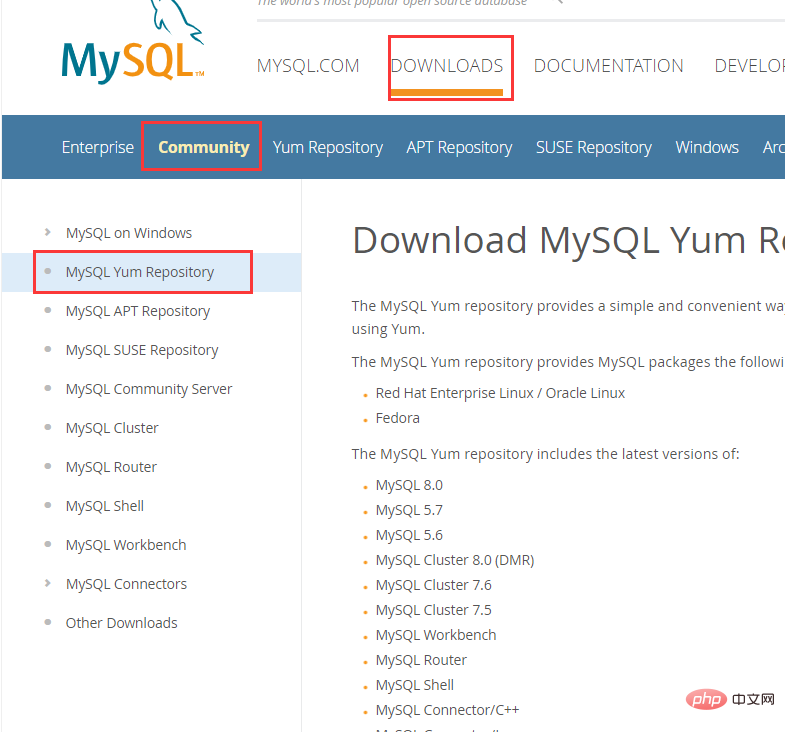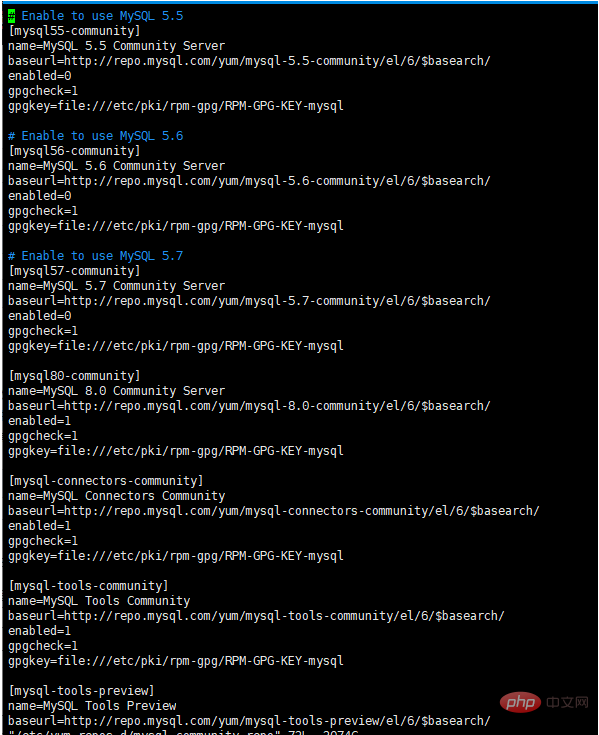How to install mysql on centos 6.5?

How to install mysql on centos 6.5:
1. Upload related packages (*.tar.gz, etc.)
Use relevant software to upload or use Xshell to connect and download the command: yum install lrzsz
2. Install mysql5.7
1. Check whether mysql is installed locally: rpm -qa | grep mysql
2. Uninstall the local mysql: yum remove mysql package
3. Download the installation package from the official website yum repository : wget http://dev.mysql.com/get/mysql80-community-release-el6-3.noarch.rpm
or download manually And upload it to linux

Then select

I am using CentOS6.5 here, all download this
4. Install the downloaded rpm package
yum localinstall mysql80-community-release-el6-3.noarch.rpm
5. Check the available installation packages
yum repolist enabled|grep mysql

6. Next, you need to change the mysql version
vim /etc/yum.repos.d/mysql-community.repo

For example, to install version 5.7, change the enabled=1 of the 80 source into enabled=0. Then change the enabled=0 of the 5.7 source to enabled=1.
7. Install mysql
yum install mysql-community-server -y
8. Start mysql and change related configurations
1>Start mysql: service mysqld start
2>Check whether mysql starts automatically, and set it to enable automatic startup
chkconfig --list | grep mysqld
chkconfig mysqld on
3>View initial password: grep "password" /var/log/mysqld.log

4>Log in to mysql: mysql -u root -p
5>Change password: SET PASSWORD FOR 'root'@'localhost' = PASSWORD('123456');
If the modified password is too simple, an error may be reported:
ERROR 1819 (HY000): Your password does not satisfy the current policy requirements
Execute the following statement:
set global validate_password_policy=0;
set global validate_password_length=4;
Execute the modify password statement again

6>Open root account remote access
grant all privileges on *.* to 'root'@'%' identified by '123456' with grant option;
7>Refresh permission table
FLUSH PRIVILEGES;
8>Modify the character set to UTF-8
linux: vim /etc/my.cnf
Add in the [mysqld] section:
port=3306
character-set-server=utf8
Add the [client] section at the end of the file and add in the [client] section:
port=3306
socket=/var/lib/mysql/mysql.sock
default-character-set=utf8
Add in the [mysql] section:
no-auto-rehash
default-character-set=utf8
After modification, restart the mysqld service:
service mysqld restart
(Import the sql script, first use the database, then source /home/sql/test.sql)
9>Use software to test remote connection to mysql

Recommended tutorial: "centos tutorial"
The above is the detailed content of How to install mysql on centos 6.5?. For more information, please follow other related articles on the PHP Chinese website!

Hot AI Tools

Undresser.AI Undress
AI-powered app for creating realistic nude photos

AI Clothes Remover
Online AI tool for removing clothes from photos.

Undress AI Tool
Undress images for free

Clothoff.io
AI clothes remover

Video Face Swap
Swap faces in any video effortlessly with our completely free AI face swap tool!

Hot Article

Hot Tools

Notepad++7.3.1
Easy-to-use and free code editor

SublimeText3 Chinese version
Chinese version, very easy to use

Zend Studio 13.0.1
Powerful PHP integrated development environment

Dreamweaver CS6
Visual web development tools

SublimeText3 Mac version
God-level code editing software (SublimeText3)

Hot Topics
 1386
1386
 52
52
 MySQL: Simple Concepts for Easy Learning
Apr 10, 2025 am 09:29 AM
MySQL: Simple Concepts for Easy Learning
Apr 10, 2025 am 09:29 AM
MySQL is an open source relational database management system. 1) Create database and tables: Use the CREATEDATABASE and CREATETABLE commands. 2) Basic operations: INSERT, UPDATE, DELETE and SELECT. 3) Advanced operations: JOIN, subquery and transaction processing. 4) Debugging skills: Check syntax, data type and permissions. 5) Optimization suggestions: Use indexes, avoid SELECT* and use transactions.
 How to open phpmyadmin
Apr 10, 2025 pm 10:51 PM
How to open phpmyadmin
Apr 10, 2025 pm 10:51 PM
You can open phpMyAdmin through the following steps: 1. Log in to the website control panel; 2. Find and click the phpMyAdmin icon; 3. Enter MySQL credentials; 4. Click "Login".
 MySQL: An Introduction to the World's Most Popular Database
Apr 12, 2025 am 12:18 AM
MySQL: An Introduction to the World's Most Popular Database
Apr 12, 2025 am 12:18 AM
MySQL is an open source relational database management system, mainly used to store and retrieve data quickly and reliably. Its working principle includes client requests, query resolution, execution of queries and return results. Examples of usage include creating tables, inserting and querying data, and advanced features such as JOIN operations. Common errors involve SQL syntax, data types, and permissions, and optimization suggestions include the use of indexes, optimized queries, and partitioning of tables.
 How to use single threaded redis
Apr 10, 2025 pm 07:12 PM
How to use single threaded redis
Apr 10, 2025 pm 07:12 PM
Redis uses a single threaded architecture to provide high performance, simplicity, and consistency. It utilizes I/O multiplexing, event loops, non-blocking I/O, and shared memory to improve concurrency, but with limitations of concurrency limitations, single point of failure, and unsuitable for write-intensive workloads.
 Why Use MySQL? Benefits and Advantages
Apr 12, 2025 am 12:17 AM
Why Use MySQL? Benefits and Advantages
Apr 12, 2025 am 12:17 AM
MySQL is chosen for its performance, reliability, ease of use, and community support. 1.MySQL provides efficient data storage and retrieval functions, supporting multiple data types and advanced query operations. 2. Adopt client-server architecture and multiple storage engines to support transaction and query optimization. 3. Easy to use, supports a variety of operating systems and programming languages. 4. Have strong community support and provide rich resources and solutions.
 MySQL's Place: Databases and Programming
Apr 13, 2025 am 12:18 AM
MySQL's Place: Databases and Programming
Apr 13, 2025 am 12:18 AM
MySQL's position in databases and programming is very important. It is an open source relational database management system that is widely used in various application scenarios. 1) MySQL provides efficient data storage, organization and retrieval functions, supporting Web, mobile and enterprise-level systems. 2) It uses a client-server architecture, supports multiple storage engines and index optimization. 3) Basic usages include creating tables and inserting data, and advanced usages involve multi-table JOINs and complex queries. 4) Frequently asked questions such as SQL syntax errors and performance issues can be debugged through the EXPLAIN command and slow query log. 5) Performance optimization methods include rational use of indexes, optimized query and use of caches. Best practices include using transactions and PreparedStatemen
 MySQL and SQL: Essential Skills for Developers
Apr 10, 2025 am 09:30 AM
MySQL and SQL: Essential Skills for Developers
Apr 10, 2025 am 09:30 AM
MySQL and SQL are essential skills for developers. 1.MySQL is an open source relational database management system, and SQL is the standard language used to manage and operate databases. 2.MySQL supports multiple storage engines through efficient data storage and retrieval functions, and SQL completes complex data operations through simple statements. 3. Examples of usage include basic queries and advanced queries, such as filtering and sorting by condition. 4. Common errors include syntax errors and performance issues, which can be optimized by checking SQL statements and using EXPLAIN commands. 5. Performance optimization techniques include using indexes, avoiding full table scanning, optimizing JOIN operations and improving code readability.
 Monitor Redis Droplet with Redis Exporter Service
Apr 10, 2025 pm 01:36 PM
Monitor Redis Droplet with Redis Exporter Service
Apr 10, 2025 pm 01:36 PM
Effective monitoring of Redis databases is critical to maintaining optimal performance, identifying potential bottlenecks, and ensuring overall system reliability. Redis Exporter Service is a powerful utility designed to monitor Redis databases using Prometheus. This tutorial will guide you through the complete setup and configuration of Redis Exporter Service, ensuring you seamlessly build monitoring solutions. By studying this tutorial, you will achieve fully operational monitoring settings




